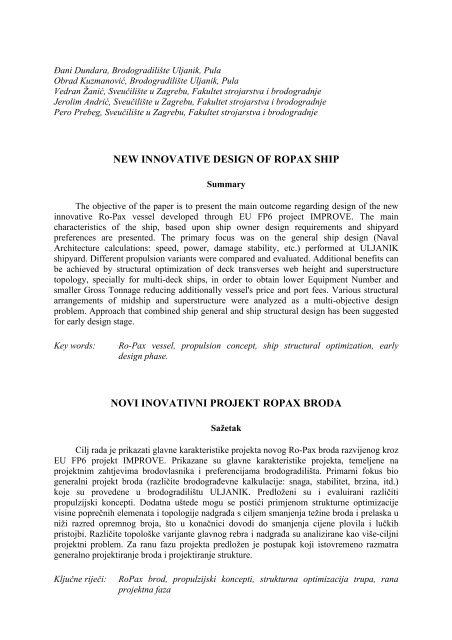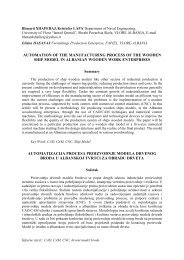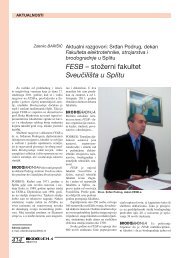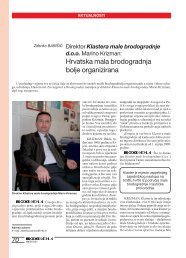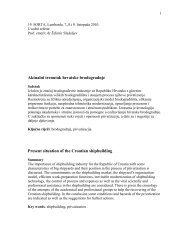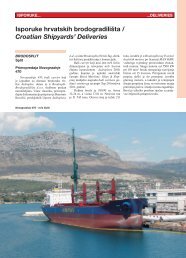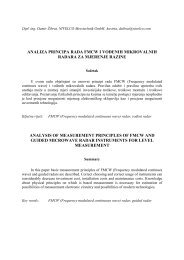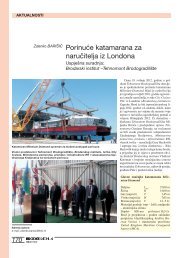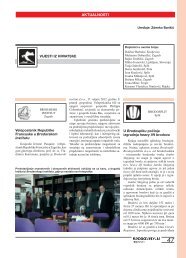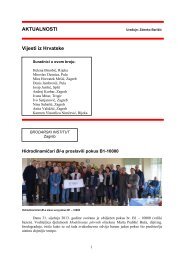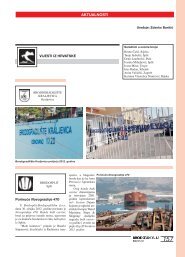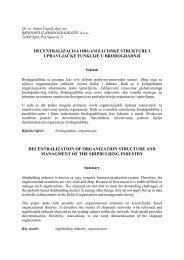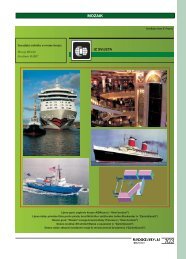NEW INNOVATIVE DESIGN OF ROPAX SHIP NOVI INOVATIVNI ...
NEW INNOVATIVE DESIGN OF ROPAX SHIP NOVI INOVATIVNI ...
NEW INNOVATIVE DESIGN OF ROPAX SHIP NOVI INOVATIVNI ...
Create successful ePaper yourself
Turn your PDF publications into a flip-book with our unique Google optimized e-Paper software.
Đani Dundara, Brodogradilište Uljanik, PulaObrad Kuzmanović, Brodogradilište Uljanik, PulaVedran Žanić, Sveučilište u Zagrebu, Fakultet strojarstva i brodogradnjeJerolim Andrić, Sveučilište u Zagrebu, Fakultet strojarstva i brodogradnjePero Prebeg, Sveučilište u Zagrebu, Fakultet strojarstva i brodogradnje<strong>NEW</strong> <strong>INNOVATIVE</strong> <strong>DESIGN</strong> <strong>OF</strong> <strong>ROPAX</strong> <strong>SHIP</strong>SummaryThe objective of the paper is to present the main outcome regarding design of the newinnovative Ro-Pax vessel developed through EU FP6 project IMPROVE. The maincharacteristics of the ship, based upon ship owner design requirements and shipyardpreferences are presented. The primary focus was on the general ship design (NavalArchitecture calculations: speed, power, damage stability, etc.) performed at ULJANIKshipyard. Different propulsion variants were compared and evaluated. Additional benefits canbe achieved by structural optimization of deck transverses web height and superstructuretopology, specially for multi-deck ships, in order to obtain lower Equipment Number andsmaller Gross Tonnage reducing additionally vessel's price and port fees. Various structuralarrangements of midship and superstructure were analyzed as a multi-objective designproblem. Approach that combined ship general and ship structural design has been suggestedfor early design stage.Key words:Ro-Pax vessel, propulsion concept, ship structural optimization, earlydesign phase.<strong>NOVI</strong> <strong>INOVATIVNI</strong> PROJEKT <strong>ROPAX</strong> BRODASažetakCilj rada je prikazati glavne karakteristike projekta novog Ro-Pax broda razvijenog krozEU FP6 projekt IMPROVE. Prikazane su glavne karakteristike projekta, temeljene naprojektnim zahtjevima brodovlasnika i preferencijama brodogradilišta. Primarni fokus biogeneralni projekt broda (različite brodograđevne kalkulacije: snaga, stabilitet, brzina, itd.)koje su provedene u brodogradilištu ULJANIK. Predloženi su i evaluirani različitipropulzijski koncepti. Dodatna uštede mogu se postići primjenom strukturne optimizacijevisine poprečnih elemenata i topologije nadgrađa s ciljem smanjenja težine broda i prelaska uniži razred opremnog broja, što u konačnici dovodi do smanjenja cijene plovila i lučkihpristojbi. Različite topološke varijante glavnog rebra i nadgrađa su analizirane kao više-ciljniprojektni problem. Za ranu fazu projekta predložen je postupak koji istovremeno razmatrageneralno projektiranje broda i projektiranje strukture.Ključne riječi:RoPax brod, propulzijski koncepti, strukturna optimizacija trupa, ranaprojektna faza
Đ. Dundara, O. Kuzmanović, etc. New Innovative Design of Ro-Pax Ship1. IntroductionThe main objective of the EU FP6 IMPROVE project was to design 3 different types ofa next generation vessels by integrating different aspects of ship structural design into oneformal framework and applying it [1]. The nature of shipbuilding in Europe is to build smallseries of very specialized ships (the opposite of the Korean and Chinese shipyards). Thus, theIMPROVE project has addressed ships which, with their complex structures and designcriteria, are at the top of the list for customization. The IMPROVE consortium has identifiedthe next generation of Large <strong>ROPAX</strong> ship, Product/chemical carrier and LNG gas carrier asthe vessels the most suitable for European yards to focus their energies on [2] and [3].ULJANIK Shipyard in the last 10 years has designed several car-carriers, ConRo and<strong>ROPAX</strong> vessels for different ship-owners [4]. For a long period ULJANIK has strongcooperation with GRIMALDI GROUP as respectable ship owner regarding market needs andtrends.In Owner definition: RoPax Vessels are built to combine two genres of transport: theroll on roll of services (as trailer, semi trailers, cars and special cargo) and the passengertransfer, and of course to take profit out it. A close cooperation between the Shipyard and theOwner during the design phase and during the preparation of the technical specification is akey point to achieve above results. The development of the new products required aconcurrent design, where new product design generations have to be developed in a multiplecriteria decision making environment including multiple objective design and multipleattribute design evaluation stages. Overall goal is to increase the ship-owner’s profit while atthe same time to reduce shipyard production cost. To maximize the key performanceindicators (KPI) for a multi-deck RoPax ship, various aspects of ship structural design wereintegrated into the multi-criteria (MC) optimization process. It is using, besides existingmethods and tools, a number of new tools developed within IMPROVE project. Theprocedure was mainly split into two interconnected levels:(1) general ship design (GD) – optimization and selection.(2) ship structural design (SD) – optimization, selection and analysis.Regarding general ship design the targets were:• Selection of resistance friendly hull form,• Smaller propulsion engine for the same speed,• Reduced fuel oil consumption,• Selection of a hull form in order to reduce a length of the engine room (increasedlength of cargo space).Regarding ship structural design the targets were:• Lower VCG (better stability).• Reduced light ship weight (reduced displacement and propulsion power)• Reduced maintenance costTo achieve defined objectives an existing line of vessels, as designed by ULJANIKshipyard and GRIMALDI GROUP, was re-assessed (structural limit states, production cost,maintenance assessment).
New Innovative Design of Ro-Pax ShipĐ. Dundara, O. Kuzmanović, etc.2. General ship designThe primary focus was on the general ship design (Naval Architecture calculations:speed, power, damage stability, etc.) performed at ULJANIK and corresponding comparisonsof selected propulsion variants. Within set requirements, the design considered large variationsin seasonal trade (summer 1600pax, winter 100pax). The design was based on a successfulexisting contemporary ship, used as a prototype (Level 1).The design methodology in the IMPROVE project defines three design levels:I. STANDARD <strong>SHIP</strong> is the existing ship or Yard prototype,II. <strong>NEW</strong> <strong>SHIP</strong> was designed during the first period of the project. The design was realizedusing mainly the existing methodology and will include improvements to the maindimensions, general arrangement, hydrodynamics and propulsion,III. IMPROVEd <strong>SHIP</strong> was obtained starting from the Level II design and using resultsfrom multi-criteria structural optimization.Fig. 1 Standard Ro-Pax Ship-Level ISlika 1. Standardni projekt Ro-Pax broda-Nivo IThe project of Ro-Pax, developed before ten years by ULJANIK, has been consideredas standard ship, Fig.1. The main characteristics of this ship are given below.• Main dimensions: Length overall – 193 + 4 m, Breadth – 29.0 m, Draft design – 6.7 m• Trial speed – 24.5 knots• Cargo capacities – Trailers 3000 lane meters + 300 cars• Capacities: HFO – 1400 m 3 , DO – 250 t, FW – 1200 m 3 , SW – 600 m 3• Passengers: 166 cabins + 400 aircraft seats• Crew 74 cabins• The designed ship had to be propelled by two pods behind two skegs.The optimized design (Level II), see Fig.2, has significant advantages as comparedwith reference RoPax ship(Level I), such as improved redundancy and simplicity ofsystems, improved manoeuvrability, optimized seakeeping and maximized comfort.
Đ. Dundara, O. Kuzmanović, etc. New Innovative Design of Ro-Pax ShipFig. 2 New Ro-Pax ship design-Level IISlika 2. Novi projekt Ro-Pax broda-Nivo IIMain dimensions of <strong>ROPAX</strong> concept design are optimized using TRIDENT/SEAKINGsoftware (ULJANIK/USCS software [5]) in order to obtain minimal main engine power andsufficient stability. The cargo capacities, restrictions of main dimensions, trial speed etc. aredefined by ship-owner request. A new application was developed, which finds a bestcombination of main dimensions in order of minimize resistance. Original hull form wasUljanik's biggest PCTC, which was then transformed into new (Level II) form with smallerresistance, see Fig. 3.Fig.3 Body Lines of RoPax (Level II)Slika 3. Brodske linije Ro-Pax broda-Nivo IIIn comparison with standard ship, optimized design needs 2900 kW (abt. 11 %) lesspower due to different main particulars and hull form.The main characteristics of a new ship:• Length overall abt 193 m• Length between perpendiculars: 180 m• Breadth: 29.8 m• Design draft: 7.5 m• Block coefficient: 0.53• Trial speed: 24.5 knots• Main engine power (MCR): 14940 kW• Active rudder output: 5000 kW• Capacities: HFO – 860 m 3 , DO – 440 t, FW – 1000 m 3 , SW – 600 m 3• Passengers: 350 cabins + 200 aircraft seats• Crew 85 cabinsLoading/unloading of vehicles is done via stern ramp over four decks. Trucks andtrailers are parked on tank top, freeboard deck and upper deck, while cars and smaller vehicles
New Innovative Design of Ro-Pax ShipĐ. Dundara, O. Kuzmanović, etc.are located on second deck. The total lane length is 3000 m plus 300 cars. There are two fixedramp ways for transport connection between decks, one going from tank top to main deckwith bridge extension to second deck and the other from main to upper deck. Passengerembarkment is done also via stern ramp over elevators to accommodation decks.After the optimization of main particulars, two propulsion design alternatives wereinvestigated, see Fig.4:Variant I: One slow speed main engine directly coupled to fix pitch propeller with oneactive rudder with propulsion bulb to increase main propeller efficiency. Auxiliary propelleris driven by direct electric drive of 5000 kW using bevel gears at the top and the bottom of theleg (inside circular torpedo body). Planetary gears for steering are driven by frequencycontrolled electric motors. Engine room space is divided into three parts: main engine roomwith main engine with power of 14900 kW, auxiliary engine room with 4 engines with totalpower of about 9000 kW and electric converters room for driving active rudder propeller.Variant II: Two medium speed main engines coupled via gearbox to CP-propeller withtwo retractable side thrusters. Engine room space is divided into four parts: main engine roomwith main two engines of 8400 kW each, auxiliary engine room with 4 engines with totalpower of about 8000 kW, bow retractable thruster room and electric stern retractable thrusterroom. Retractable thrusters will operate in port only.Fig. 4 Different propulsion solutions-Level IISlika 4. Različita propulzijska rješenja-Nivo IIThe main idea of novel propulsion concept is to avoid as much as possible the runningof electrically driven thrusters in seagoing condition, i.e. to use it only during manoeuvring inharbour (no tugs) and to have two independent sources of propulsion in order to obtain 100%redundancy notation. The owner requirement was that ship must never stop and requestedselection of two main engines coupled via gearbox to one CP-propeller (Variant II). Thisarrangement gives the possibility to operate vessel with one main engine running and carryout maintenance on the other main engine. The selected Variant II arrangement shows 9%smaller efficiency compared to Variant I.Goals regarding achievement in fuel oil consumptions and increased lane meter on tanktop (cargo capacity) have been achieved. In comparison with Standard ship, New design(Level II) needs almost 7900 kW less power, weight of machinery is reduced by 450 t, fuel oilconsumption is 28% less and finally, propulsion system is more reliable. Index of redundancyis 100% (2 independent engine rooms and 2 independent propulsion systems).Final IMPROVEd ship (Level III) has been obtained using multi-criteriastructure/general design optimization results given in Ch.3.
Đ. Dundara, O. Kuzmanović, etc. New Innovative Design of Ro-Pax Ship3. Multi-criteria structural design optimizationThe main idea of Level III is to further increased savings obtained on the Level IIdesign by implemented structural design optimization in connection with general shipcalculations.3.1. Structural optimizationOn the general ship level, several topological/geometrical concepts have been proposedand evaluated based on new ship design (Level II) which served as prototype. Two differentconcepts of superstructure were attached to each of three midship section variants proposedby ULJANIK. In that way a total number of six different model variants were formulated inorder to perform structural optimization for each of them, Fig. 5:1. Number of superstructure decks. Two variants of superstructure (x T : two andthree tiers), but with the same total area of accommodation decks.2. Transverse position of longitudinal bulkhead between deck 1 and deck 3 (x G ).Three different positions have been examined.Fig. 5 RoPax Topological/geometrical design variantsSlika 5. RoPax topološke/geometrijske projektne varijableFor a concept structural design of multi-deck ships (such as Ro-Pax) an efficient multistep procedure have been established to solve topology (and interwoven scantling/geometry)optimization via two main tasks [6] and [7]:(A) topology / geometry optimization(B) scantling / material optimization of the preferred variants from task (A)Generic tapered ship 3D FEM models based on gross-elements/surrogates [8] accordingto class Rules, was selected as the appropriate model for structural optimization of both task.Each of the six extruded generic 3D FEM models were generated in MAESTRO structuraldesign software [9], see Fig. 6.
New Innovative Design of Ro-Pax ShipĐ. Dundara, O. Kuzmanović, etc.Fig. 6 MAESTRO 3D generic model of RoPax shipSlika 6. MAESTRO 3D generički MKE model RoPax brodaThe design variables used are divided into topological, geometrical and scantlingvariables, see Table 1. The topological variable was the number of superstructure decks (x T :two and three tiers). The geometrical variable was the breadth of lower hold (x G : threedifferent position of longitudinal bulkhead in cargo space). The scantling variables werescantlings of structural elements (x S : 14 scantling variables per stiffened panel). x T and x G arevery important on the general ship level because their reduction could possibly reduceequipment number (cost of equipment). Shipyard supplied constraint function for equipmentnumber based upon geometrical design variables used in optimization process. Also, byincreasing the lower hold breadth, a total gross tonnage also increases.Table 1. Design variablesTablica1. Projektne varijableDesign<strong>DESIGN</strong> VARIABLES PROPERTIESvariables type Name Min Max Step CommentNumber of SS decks 2 3 1Booth version have the same area ofaccommodation decksLower hold breadth 15360 mm 17760 mm 1200 mmOne or more car lane (height of deck3 is function of this variable)Structural elementsMin/Max values based on class.rules, technology demands,experience, etc.Structural optimization of different design concepts for given objectives (cost, mass,VCG, safety, etc.) w.r.t. the topological, geometrical and scantling variables enables their faircomparison. In the context of general design, designer’s selection should be performed assecond design task, using the global design quality measures on the grid of optimizedvariants. In parallel with the structural part, ULJANIK performed general naval architecturecalculations (damage stability, power, resistance, cargo capacity, etc.) for each of threemidship section variants. Also, for each variant the damage stability calculations have beenperformed to achieve minimal depth of freeboard deck (height of Deck 3) which satisfiesdamage stability criteria.
Đ. Dundara, O. Kuzmanović, etc. New Innovative Design of Ro-Pax ShipEach panel can contain plating, stiffeners, transverse frames and longitudinal girder).Design constraints and requirements were:(a) Minimum and maximum values for the height of frame web of deck transversesspecified by shipyard;(b) Minimum values for the thickness of plating and stiffener section modulusdetermined according to the requirements of BV, as minimum allowable thicknessof plating and section modulus that can support wheel loads [10];(c) To satisfy structural strength, the adapted set of MAESTRO adequacy parameterswas used [11].The design objectives used for optimization of all six structural variants were: structuralweight, cost of material and position of vertical centre of gravity (VCG). All variants wereoptimized using MAESTRO SLP optimization algorithm during 10 design cycles. Mass, costand VCG of each model were calculated using MAESTRO inbuilt functions. Safety measureswere determined using normalized adequacy criteria. Relative adequacy index [11], has beencalculated for all three modules used in optimization (S1M1, S1M2 and S1M3). Height ofship for proposed models was determined after the optimization was performed. Based on thecomparison between all six models (initial and proposed) the following results have beenachieved:• Total mass of each model was successfully decreased by approximately 200 to 300 tfor all variants (depending on a model).• Production cost and VCG were successfully decreased.• Safety was increased due to smaller number of unsatisfied constraints and greaterrelative adequacy index.• Height of all models was slightly increased due to greater height of transversebeams of decks 2 and 3.Fig. 7 shows the structural mass cycle-history as well as the changes in total number ofunsatisfied constraints with respect to the cycle number for design RoPax 22.Fig. 7 Design history of mass and safety for RoPax 22Slika 7. Promjena mase i sigurnosti po projektnim ciklusima za projekt RoPax 22
New Innovative Design of Ro-Pax ShipĐ. Dundara, O. Kuzmanović, etc.Influences of x T and x G on the structural design are briefly summarized:The main differences between two superstructure concepts (x T ), one with two tiers(RoPax 20, 21 and 22) and those with three superstructure decks (RoPax 30, 31 and 32), is inlongitudinal (hull girder) stress distribution along the ship height/length. Due to the fact thatsuperstructure with two decks is very long, about 80-90% of ship length, it participates in thehull global bending with more efficiency then variants with much shorter superstructure withthree decks. Comparison of longitudinal stresses for LC2 is given for two variants RoPax 22and RoPax 30, see Fig.8.RoPax 22 RoPax 30Fig. 8 Longitudinal primary stresses distribution for two variants RoPax 22 and RoPax 30Slika 8. Uzdužna primarna naprezanja za dvije varijante RoPax 22 i RoPax 30The contribution of superstructure decks to the primary strength for RoPax 30 is low.This variant is also characterized with the stress concentration areas at the position of theconnection of the superstructure end with the upper hull deck (Deck 6). It affects stressdistributions over cross section height and causes higher stresses in Deck 6 (highest lower hulldeck) and increases compression stresses in the bottom plating, compared to RoPax 22variant. Higher compression stresses lead to thicker bottom plating to prevent the bucklingproblems. The reduction in mass of RoPax 22 for about 60t is achieved compared toRoPax 30.Transverse position of longitudinal bulkhead between Deck 1 and Deck 3 (x G ) has aninfluence mainly on the transverse beams scantlings on Deck 2 and 3. Its influence isrelatively low with respect to the completely structural mass. As it was expected, the variantsRoPax- 20 and RoPax-30 resulted in the smallest scantlings of transverse beams for bothdecks due to smaller unsupported beam length.3.2. Design selectionStructural optimization of a real ship can offer a significant help to the ship designerbecause it can optimally redistribute material, reducing weight of initial model and increasingits safety. Also, a total number of six RoPax ship model variants were investigated in order todetermine the best variant with respect to multiple objectives (lowering of ship height,minimization of total mass, cost and position of vertical centre of gravity, safety criteria).Based on structural optimization results and additional general naval architecture calculation
Đ. Dundara, O. Kuzmanović, etc. New Innovative Design of Ro-Pax Shipof ship damage stability and cargo handling for all variants, designer has specified six criteriafor the final selection:• Parking Area, • Ship stability, • Air draught,• Production measure, • Passenger comfort • Structural SafetyValues of six design attributes are summarized in Fig. 9 for all six examined RoPaxvariants (6 generic FEM models for: 2 variants of superstructure x 3 variants of LBHD-Fig. 5.VARIANTNAMERoPax 30RoPax 31RoPax 32RoPax 20RoPax 21RoPax 22Fig. 9 Values of design attributes for different variantsSlika 9. Vrijednost projektnih atributa za različite projektne varijanteDesigner’s and Owner’s subjective intra-attribute and inter-attribute preferences wererevealed. Novak’s fuzzy functions were used to model intra-attribute preferences, Fig.10,while Saaty’s AHP method was used for inter-attribute preferences [12].Fig. 10 Intra attribute preferences-fuzzy functionSlika 10. Neizrazite funkcije- unutar atributne preferencijeFinal selection of the preferred variants was performed by ULJANIK shipyard headdesigner on the Parallel axis plot of selected criteria’s in OCTOPUS Designer DeView Tool(see Fig.11) based on Designer’s and Ship Owner’s subjective intra-attribute and interattributepreferences.
New Innovative Design of Ro-Pax ShipĐ. Dundara, O. Kuzmanović, etc.Legend: Design 1 - RoPax 30; D2 - RoPax 31; D3 - RoPax 32; D4 - RoPax 20; D5 - RoPax 21; D6 - RoPax 22Fig. 11 Parallel axis plot of criteria for all six variantsSlika 11. Prikaz svih šest projektnih varijanti pomoću paralelnih osiThe variant RoPax 22 has been chosen as preferred solution. Some of the highlights ofthe preferred RoPax 22 variant are:(1) Additional 403.2 m 2 of parking area with respect to the starting variant RoPax 30.Parking area Deck 2 = +201.6 m 2 × 3000 Euro/m 2Parking area Deck 1 = +201.6 m 2 × 5000 Euro/m 2= + 604800 euro= +1008000 euroTotal parking area = +403.2 m 2 = +1612800 euro(2) No additional ballasting – the vessel will sail at smaller draught in arrival condition,(3) 2.5 m smaller air draught with respect to RoPax 32,(4) Reduced weight of wing tank blocks and smaller distance to water line, whichdirectly improves passenger comfort.(5) Structure inside wing tanks is modified in a way that three stringers are added P/Sin order to avoid erection of scaffoldings for inspection of Voids P/S. It will makeeasier Class inspection.Selection performed presents the interaction of General Design (GD) procedure andStructural Design (SD) procedure in the first design cycle.Final IMPROVEd ship (Level III) has 4 % less lightship weight in comparison with NewIMPROVE ship (Level 2) and because of this, the required propulsion power and fuel oilconsumption are 5 % less (19560 kW instead of 20500 kW). The gain of 5% more trailerlanes (cargo capacity) on tank top is achieved by investigating different positions oflongitudinal ballast tank bulkhead and at the same time ballast volume is minimized.4. ConclusionsAn innovative RoPax design has resulted following a multi-stakeholder approach whereshipyards and ship-operators were involved. To maximize the key performance indicators(KPI) for a RoPax product various aspects of ship structural design were integrated into themulti-criteria optimization process.
Đ. Dundara, O. Kuzmanović, etc. New Innovative Design of Ro-Pax ShipIMPROVE goals regarding achievement in fuel oil consumptions (12%) and increasedcargo capacity of about 5% more trailer lanes on tank top has been achieved. Ship-ownerprofit has been significantly increased due to reduction in fuel consumption (better propulsionand ship hull form, reduced weight, etc.), increase in payload (increased parking area).Various structural arrangements were analyzed by ULJANIK and UZ as a multiobjectivedesign problem. Structural optimization obtained savings in cargo space weight ofapprox. 300 tons in which influenced general ship design (Level III) in terms of additionalreduction of required propulsion power for 5% compared to the same propulsion systemimplementer in new ship (Level II). Also, the preferred topological/geometrical concept(RoPax 22) has been chosen and served as the starting point for the more detailed structuraloptimization.Presented approach gives Yards and Owners a possibility to select competitive designsolutions by following the basic IMPROVE paradigm: better ship for the Yard production andmore profitable ship for Owner regarding maintenance and operational aspects within LCC.Presented work represents the successful cooperation and joint work of Yard andFaculty design teams as an example of modern design approach in very early design phase.ACKNOWLEDGEMENTThanks are due to Croatian Ministry of Science, Education and Sport: projects 120-1201829-1671 and the EU Commission under the FP6 Sustainable Surface TransportProgramme, project IMPROVE, Contract No. FP6-031382 for supporting the part of thestudy. Thanks are due to all members of the OCTOPUS group (www.fsb.hr/octopus) and to thedesign team of the ULJANIK shipyard (www.uljanik.hr) for fruitful and long term cooperation.REFERENCES[1] IMPROVE Consortium (2009), "Proceedings of Final IMPROVE Workshop", Dubrovnik, Croatia,September 2009, all papers available on http://www.improve-project.eu/.[2] D. Dundara, B. Ferlatti, O. Kuzmanović, I. Lalović (2008), "Development of a New Innovative Conceptof Ropax Ship Project IMPROVE", XVIII Symposium on Theory and Practice of Shipbuilding-SORTA2008, pp.187-197, Pula, 2008.[3] V. Zanic, P. Prebeg, J. Andric, S. Kitarovic, M. Grgic (2008), "Multicriteria structural design of ropaxship: specification of design problem roadmap for EU FP6 Project IMPROVE", XVIII Symposium onTheory and Practice of Shipbuilding-SORTA 2008, pp.267-278, Pula, Croatia.[4] V. Zanic, T. Jancijev, J. Andric, D. Frank, S. Bralic, D. Sponza, D. Dundara (2001), "Racking Analysis ofCar-Truck-Carriers", Brodogradnja, 49, Vol. 2, pp. 181-190.[5] Trident User manual, Uljanik Shipbuilding Computer System, http://www.uscs.hr/.[6] V. Zanic, J. Andric, P. Prebeg (2009), "Design Environment for Structural Design: Application to ModernMultideck Ships", Proc.IMechE, part M, J. of Engineering for the Maritime Environment, Vol.223,No.M1, pp.105-120.[7] V. Zanic, J. Andric, P. Prebeg, S. Kitarovic, K. Piric (2009), "Multi-Objective Optimization of ShipStructural Topology and Scantlings", Proc. of 10th Int. Marine Design Conference IMDC, Trondheim.[8] J. Andric and V. Zanic (2010), "The Global Structural Response Model for Multi-Deck Ships in ConceptDesign Phase", Ocean Engineering 37 (2010) 688-704.[9] MAESTRO Version 8.9. (2009), Program documentation, DRS Technologies,http://www.orca3d.com/maestro/.[10] BV (2007), Rules for the Classification of Steel Ships - December 2003 Edition, Bureau Veritas, France.[11] O.F. Hughes, F. Mistree, V. Zanic (1980), "A Practical Method for the Rational Design of ShipStructures", Journal of Ship Research, Vol. 24.[12] T. L. Saaty (1990), "How to make a decision: The Analytic Hierarchy Process" European Journal ofOperational Research 48, pp. 9-26, North-Holland.


